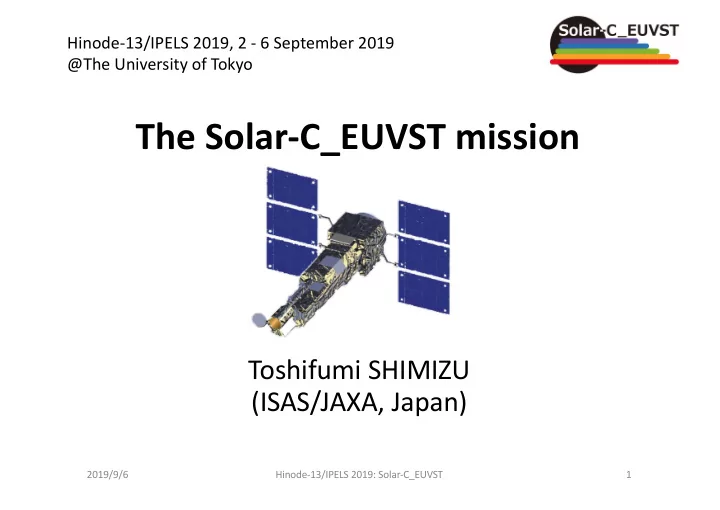

Hinode-13/IPELS 2019, 2 - 6 September 2019 @The University of Tokyo The Solar-C_EUVST mission Toshifumi SHIMIZU (ISAS/JAXA, Japan) 2019/9/6 Hinode-13/IPELS 2019: Solar-C_EUVST 1
New observations, better understanding Yohkoh Hinode (2006-present) (1991-2000 ) Magnetic behaviors at the surface Dynamic chromosphere (image) Pieces of evidence for MR IRIS (2013-present ) SDO SoHO (NASA) (2010-present) (1995-present) Convection zone probed with helioseismology Full Sun monitoring for CME evolution Quantified dynamic space weather with coronagraph chromosphere 2019/9/6 Hinode-13/IPELS 2019: Solar-C_EUVST 2
Better understanding of MHD processes, advanced with Hinode observations waves magnetic reconnection Acceleration, turbulence local (source of solar wind) dynamo MHD instability Magneto-convection 2019/9/6 Hinode-13/IPELS 2019: Solar-C_EUVST 3
New observations, better understanding Yohkoh Hinode (2006-present) (1991-2000 ) Magnetic behaviors at the surface Dynamic chromosphere (image) Pieces of evidence for MR IRIS (2013-present ) SDO SoHO (NASA) (2010-present) (1995-present) Convection zone probed with helioseismology Full Sun monitoring for CME evolution Quantified dynamic space weather with coronagraph chromosphere 2019/9/6 Hinode-13/IPELS 2019: Solar-C_EUVST 4
Solar-C_EUVST mission = = Solar-C C EUV Hi High-th throughput t Spectr trosc scopic Telesc scope CCD/IAPS radiator panels EUVST-Bus I/F CFRP structure �� Guide telescope Aperture door Mirror assembly Heat dump Spacecraft bus Optical bench CCD IAPS E-box Slit Slit-jaw imager Grating • Down-selected as a candidate for JAXA competitive M-class missions in July 2018, to be launched by a JAXA Epsilon vehicle in 2025. 2019/9/6 Hinode-13/IPELS 2019: Solar-C_EUVST 5
Science goals of the mission The importance of observing the solar atmosphere • How the plasma universe is created and evolves? • How the Sun influences the Earth and other planets in our solar system? Earth Sun The interplay of magnetic fields and plasma creates behaviors Quasi-steady: corona, solar winds Energy and mass transfer and energy dissipation Transient: Flares, CMEs 6 2019/9/6 Hinode-13/IPELS 2019: Solar-C_EUVST
Solar-C_EUVST: Scientific objectives II. Understand how the solar I. Understand how fundamental atmosphere becomes unstable, processes lead to the formation releasing the energy that drives of the solar atmosphere and the solar flares and eruptions solar wind Low- b Corona (>1 MK) With too different spatial resolution for the corona, impossible for the existing instruments to trace the energy and mass transport toward the corona. 10000 km Magnetically coupled T ~ 10 6 - 10 7 K Hinode/SOT ~0.3” The energy injected from underneath is finally released, leading to the hot corona, the solar wind, and coronal mass ejections. C o r o n a T T ~ 10 5 K r a n s i t i o n r e g i o n The Alfvén and sound speeds both increase rapidly with height, 2000 km playing critical role in the energy transfer. U p p e r c h r o m o s p h e r e T ~ 10 4 K Hinode/EIS Regulates the mass and energy loading into the corona by Resolution ~ 3” L o w e fine-scale dynamics, such as jets and waves. r c h r o m o s p h e r e 80000 km P h o t T ~ 6000 K o s p h e r i c m a g n e t i c f i e l d Turbulent convection and its interaction with magnetic fields are the source of energy injection into the outer atmosphere. 1 6 0 0 0 0 k m Hinode/SOT Resolution ~ 0.3” High- b Photosphere (6000 K) 2019/9/6 Hinode-13/IPELS 2019: Solar-C_EUVST 7
Solar-C_EUVST: Scientific objectives II. Understand how the solar I. Understand how fundamental atmosphere becomes unstable, processes lead to the formation releasing the energy that drives of the solar atmosphere and the solar flares and eruptions solar wind Ideal MHD instability Reconnection Flare trigger 2019/9/6 Hinode-13/IPELS 2019: Solar-C_EUVST 8 Tsuneta 1997 提案するミッションコンセプトは当該分野になにをもたらそうとするのか
To achieve the scientific objectives, The EUVST is designed to make three significant advances A: Seamlessly observe all the temperature regimes of the atmosphere from the chromosphere to the corona simultaneously at the same spatial resolution (10^4-10^7 K) B: Resolve elemental structures of the solar atmosphere and track their changes with sufficient cadence (0.4”, 1 sec exposure) C: Obtain spectroscopic information on dynamics of elementary processes taking place in the solar atmosphere (Velocity, density, temperature, composition, ionization etc) 2019/9/6 Hinode-13/IPELS 2019: Solar-C_EUVST 9
Science and instrument design requirements Driving requirements from science goals à design requirements for the instrument • table 2019/9/6 Hinode-13/IPELS 2019: Solar-C_EUVST 10
Baseline architecture • Minimum number of optical components for a spectrograph to achieve high throughput performance Off-axis parabola (28 cm diameter, focal length 280 cm) makes an image on the slit. The slit selects a one-dimensional portion of the image, which is incident onto a concave diffraction grating (two gratings). The radiation dispersed in the spectral direction is imaged at detectors. 2019/9/6 Hinode-13/IPELS 2019: Solar-C_EUVST 11
EUVST EU EUV High gh-th throu oughput t Spectr ctros oscop opic c Telescop ope CCD/IAPS radiator panels EUVST-Bus I/F CFRP structure �� Guide telescope Aperture door Mirror assembly Heat dump Spacecraft bus Optical bench CCD IAPS E-box Slit Slit-jaw imager Grating • The instrument: length 3.8 m, weight ~200 kg 2019/9/6 Hinode-13/IPELS 2019: Solar-C_EUVST 12
JAXA Epsilon vehicle Spacecraft system Spacecraft installed in the fairing envelope Weight 520-550 kg Sun synchronous polar orbit (>600 km) High pointing stability, based on Hinode knowledge 2019/9/6 Hinode-13/IPELS 2019: Solar-C_EUVST 13
Performance (1/2) • 7 times higher spatial resolution (3” à 0.4”) The power to resolve about 50 times smaller features in the area size Distinguish Active-region magnetic loops overall structure The image quality of the design expected: Initial budget table 2019/9/6 Hinode-13/IPELS 2019: Solar-C_EUVST 14
Recommend
More recommend